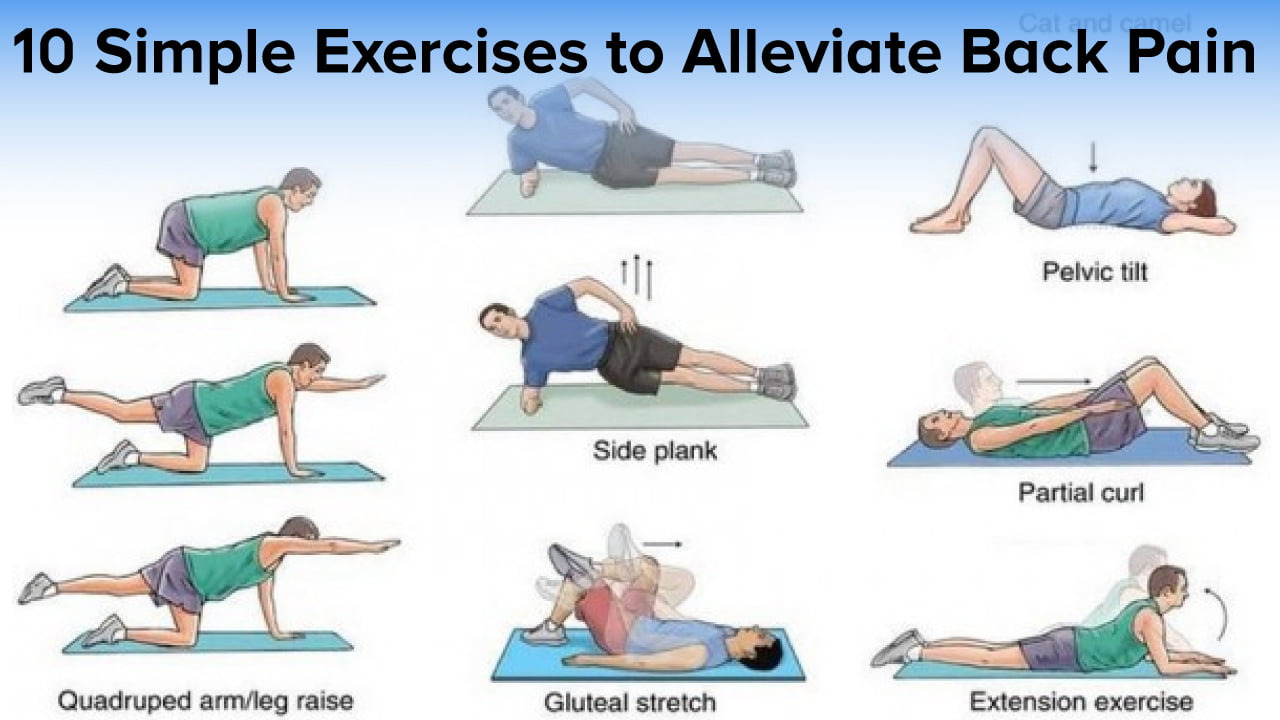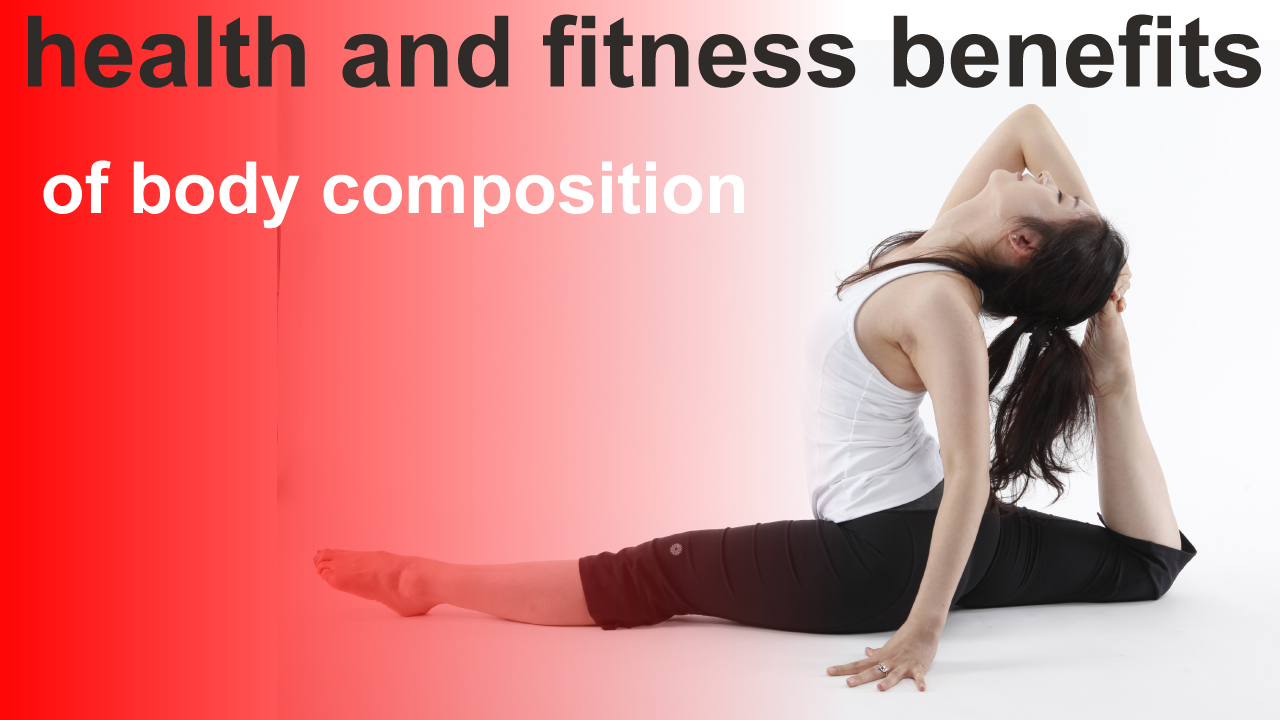Headline :
10 Simple Exercises to Alleviate Back Pain

10 simple exercises to alleviate back pain include stretching, yoga poses, and core strengthening exercises. These exercises target specific muscles to relieve pain and improve flexibility and strength.
Understanding Back Pain
Importance Of Back Health
A healthy back is crucial for overall well-being and quality of life. It provides support, stability, and mobility for our bodies, allowing us to perform daily activities without pain or discomfort. Poor back health can lead to chronic pain, limited mobility, and even long-term disability.
Therefore, it is essential to prioritize back health and take proactive steps to maintain its strength and flexibility. Regular exercise and proper posture play a significant role in preventing and alleviating back pain.
Common Causes Of Back Pain
Back pain can occur due to various factors, including:
- Muscle strain or sprain: Overexertion, lifting heavy objects incorrectly, or sudden movements can strain or sprain the muscles in the back, leading to pain and discomfort.
- Poor posture: Slouching, sitting for prolonged periods, or standing incorrectly can put excessive stress on the spine and its supporting muscles, resulting in back pain.
- Herniated disc: The discs between the spinal vertebrae can bulge or rupture, causing the inner gel-like material to press on nearby nerves, resulting in back pain.
- Arthritis: Osteoarthritis and other types of arthritis can affect the spine, leading to inflammation and pain.
- Osteoporosis: Weakening of the bones due to osteoporosis can increase the risk of fractures, including in the spine, resulting in back pain.
The Relationship Between Exercise And Back Pain
Regular exercise can be extremely beneficial in preventing and alleviating back pain. Here’s how exercise can help maintain a healthy back:
- Stronger muscles: Strengthening the muscles that support the spine, including the abdominal and back muscles, can provide better stability and reduce the chances of injury and pain.
- Improved flexibility: Stretching exercises help improve flexibility, making movements easier and reducing the risk of muscle strains and sprains.
- Weight management: Maintaining a healthy weight through regular exercise can alleviate stress on the spine and reduce the risk of developing back pain.
- Enhanced posture: Exercise that focuses on core strength and postural alignment can improve posture, reducing pressure on the spine and alleviating back pain.
- Increased circulation: Physical activity promotes blood flow, which can enhance the delivery of nutrients and oxygen to the spine, aiding in its health and healing.
- Enhanced mental well-being: Exercise releases endorphins, natural pain-relieving chemicals in the brain, which can improve mood and decrease the perception of back pain.
By incorporating simple exercises into your daily routine, you can alleviate back pain, enhance back health, and improve your overall quality of life. It’s time to prioritize your well-being and take the necessary steps to keep your back strong and pain-free.
Exercise As A Treatment For Back Pain
The Benefits Of Exercise For Back Pain:
- Regular exercise can provide significant benefits for individuals suffering from back pain.
- Exercise helps to strengthen the muscles in the back, providing better support and stability for the spine.
- It also helps to improve flexibility, increasing the range of motion and reducing stiffness in the back.
- Exercise promotes better blood circulation, which can help to reduce inflammation and promote healing.
- Engaging in physical activity can also help to release endorphins, which are natural painkillers that can alleviate back pain.
Importance Of Strengthening Core Muscles:
- Building strong core muscles is essential for alleviating back pain.
- The core muscles include the muscles in the abdomen, lower back, and pelvis.
- Strengthening these muscles helps to provide a solid foundation for the spine, reducing the risk of injuries and providing better support for the back.
- Strong core muscles also help to improve posture, reducing the strain on the back.
- Exercises that target the core muscles can help to alleviate back pain by promoting better alignment and stability.
How Exercise Helps Relieve Back Pain:
- Exercise helps to stretch and strengthen the muscles in the back, reducing the strain on the spine.
- It also helps to improve posture, which can alleviate back pain caused by poor alignment.
- Engaging in regular physical activity can also help to promote weight loss, reducing the load on the spine and easing back pain.
- Exercise improves flexibility, which can help to reduce muscle imbalances and relieve tension in the back.
- Furthermore, regular exercise promotes better overall health and well-being, reducing stress levels and improving mental and emotional well-being, which can indirectly alleviate back pain.
Remember to consult with a healthcare professional before starting any exercise regimen, especially if you have a history of back pain or any underlying health conditions. These exercises should be done under supervision and with proper guidance to prevent further injuries.
Incorporating exercises into your daily routine can provide long-term relief and improve the overall health of your back.
Exercise 1: Cat-Camel Stretch
If you’re looking for a simple and effective exercise to alleviate back pain, the cat-camel stretch is a great option. This exercise targets the muscles in your lower back and can help improve flexibility and relieve tension. Whether you’re a beginner or a fitness enthusiast, the cat-camel stretch can be modified to suit your fitness level.
Instructions For Cat-Camel Stretch
To perform the cat-camel stretch, follow these steps:
- Start by positioning yourself on all fours. Place your hands directly under your shoulders and your knees directly under your hips.
- Begin by arching your back towards the ceiling, like a cat stretching. Tuck your chin towards your chest and let your head drop slightly.
- Hold this position for a few seconds, feeling the stretch in your lower back.
- Slowly reverse the movement, dropping your belly button towards the floor and lifting your head and chest. Your back should now be arched in the opposite direction, resembling a camel’s hump.
- Pause in this position for a few seconds, feeling the stretch in your lower back.
- Repeat the cat and camel movements for 10-15 reps, moving slowly to focus on the stretch and contraction of the muscles.
Benefits Of Cat-Camel Stretch
The cat-camel stretch offers several benefits for individuals experiencing back pain:
- Loosens tight muscles: The alternating movement of the cat and camel stretch helps to loosen and relax tight muscles in the lower back.
- Increases flexibility: Regularly performing this exercise can improve flexibility and range of motion in the spine.
- Relieves tension: The gentle stretching and movement in the cat-camel stretch can help alleviate tension and stress in the back.
- Improves posture: By targeting the muscles that support the spine, this stretch can help improve posture and alignment.
Modifications For Different Fitness Levels
The cat-camel stretch can be modified to suit different fitness levels:
- Beginners: If you’re new to exercise or have a limited range of motion, you can perform a modified version of the cat-camel stretch by reducing the range of motion. Focus on gently arching and rounding your back, without pushing to the extremes of the stretch.
- Intermediate: As you become more comfortable with the exercise, aim to increase the range of motion slightly. Focus on fully arching and rounding your back, while maintaining proper form and control.
- Advanced: For a more challenging variation, you can add a resistance band around your thighs to engage the hip muscles as well. This will provide an additional strengthening and stabilizing element to the exercise.
Remember to always listen to your body and stop if you experience any pain or discomfort. If you have any existing back conditions or injuries, it’s best to consult with a healthcare professional before attempting any new exercises. Give the cat-camel stretch a try and experience the benefits of this simple yet effective exercise for back pain relief.
Exercise 2: Child’S Pose
Child’s pose is a simple yet effective exercise that can help alleviate back pain and promote relaxation. This pose is often practiced in yoga and is known for its soothing and calming effects. By gently stretching the back and relaxing the muscles, child’s pose can provide relief from tightness and discomfort.
Here’s how to do it:
Instructions For Child’S Pose
To perform child’s pose, follow these steps:
- Start by kneeling on the floor with your knees hip-width apart and your toes touching behind you.
- Sit back on your heels and slowly lower your torso down towards the ground.
- Extend your arms in front of you and place your forehead on the mat or the ground.
- Relax your shoulders and let your upper body surrender to the natural pull of gravity.
- Take deep breaths and focus on feeling a gentle stretch through your spine and lower back.
- If you feel any discomfort or pain, adjust the position of your knees, hips, or arms until you find a comfortable variation.
- Hold this pose for 1-2 minutes, or longer if desired, while maintaining relaxed and steady breathing.
- To release the pose, slowly walk your hands back towards your body and sit up on your heels.
- Take a moment to notice how your body feels before moving on to the next exercise.
- Repeat this pose as needed throughout your day to relieve tension and restore balance to your back muscles.
Benefits Of Child’S Pose
Child’s pose offers several benefits for relieving back pain and improving overall well-being:
- Stretches and elongates the spine, relieving pressure on the vertebral discs.
- Releases tension in the back, shoulders, and neck muscles.
- Promotes relaxation and reduces stress levels.
- Helps alleviate lower back pain and discomfort.
- Improves circulation and blood flow to the back muscles.
- Can be practiced as a gentle form of exercise for individuals with limited mobility.
- Provides a calming and grounding effect on the mind and body.
Variations Of Child’S Pose
Here are a few variations of child’s pose that you can try to add more depth and variation to your practice:
- Wide-legged child’s pose: Start in the traditional child’s pose but with your knees wider apart, allowing for a deeper stretch through the hips and inner thighs.
- Extended child’s pose: Instead of keeping your arms extended in front of you, reach them out to the sides as far as comfortable. This variation opens up the chest and shoulders.
- Supported child’s pose: Place a bolster or a folded blanket under your torso to provide additional support and help release tension in the lower back.
- Puppy pose: Similar to child’s pose, but with your hips lifted slightly off your heels and your arms extended forward. This variation offers a deeper stretch for the shoulders and upper back.
Remember to listen to your body and choose the variation that feels most comfortable and beneficial for you. As always, consult with a medical professional before starting any new exercise routine, especially if you have pre-existing back conditions or injuries.
Exercise 3: Bird Dog
Instructions For Bird Dog:
To alleviate back pain, incorporating the bird dog exercise into your routine can be highly beneficial. This exercise is a simple yet effective way to strengthen your core muscles and improve balance. Here are the step-by-step instructions to perform the bird dog exercise correctly:
- Start on all fours, with your hands directly under your shoulders and knees directly under your hips.
- Engage your core muscles by pulling your belly button towards your spine.
- Extend your right arm straight forward, parallel to the ground, while simultaneously extending your left leg straight back, parallel to the ground.
- Maintain a straight line from your fingertips to your toes, keeping your hips square to the ground.
- Hold this position for a few seconds, focusing on balancing and keeping your core engaged.
- Slowly lower your arm and leg back to the starting position.
- Repeat on the opposite side, extending your left arm and right leg.
- Alternate sides and perform the exercise for the desired number of repetitions.
- Aim to perform 10-15 repetitions on each side, gradually increasing the number as your strength improves.
Benefits Of Bird Dog:
The bird dog exercise offers a variety of benefits for individuals suffering from back pain. Here are some key advantages of incorporating this exercise into your routine:
- Strengthens the core muscles: The bird dog exercise primarily targets the muscles in your abdomen, lower back, and glutes. Strengthening these muscles can provide greater support to your spine.
- Improves stability and balance: By challenging your balance, the bird dog exercise helps improve the stability of your spine. This can in turn alleviate back pain caused by instability or weak core muscles.
- Enhances posture: Regularly performing bird dog can improve your posture by strengthening the muscles responsible for maintaining proper alignment of the spine.
- Targets multiple muscle groups: Besides the core muscles, the bird dog exercise also engages your shoulders, upper back, and hips, resulting in an overall increase in strength and stability.
- Low-impact exercise: The bird dog exercise is low-impact, making it suitable for individuals with back pain or those looking for a gentle form of exercise.
Tips For Proper Form:
To get the most out of your bird dog exercise and avoid strain or injury, it is important to maintain proper form. Here are some tips to ensure you perform the exercise correctly:
- Keep your spine neutral: Throughout the exercise, focus on keeping your spine in a neutral position. Avoid arching or rounding your back.
- Engage your core: Remember to engage your core muscles by pulling your belly button towards your spine. This will help stabilize your torso.
- Maintain a steady breathing pattern: Inhale deeply before starting the exercise, and exhale as you extend your arm and leg. Continue breathing steadily throughout each repetition.
- Avoid lifting your leg too high: While extending your leg, aim to keep it parallel to the ground. Lifting it excessively high can lead to unnecessary strain on your lower back.
- Start with smaller movements: If you are new to the exercise or experiencing back pain, start with smaller movements and gradually increase the range of motion as your strength improves.
By following these instructions and practicing proper form, you can effectively incorporate the bird dog exercise into your routine and experience relief from back pain. Remember to listen to your body and consult with a healthcare professional if you have any concerns or specific medical conditions.
Exercise 4: Cobra Stretch
The cobra stretch is a powerful exercise for alleviating back pain and improving flexibility in the spine. This simple yet effective stretch targets the muscles in your lower back and can provide immediate relief from discomfort. Whether you’re dealing with chronic back pain or just looking to prevent future issues, incorporating the cobra stretch into your routine can make a significant difference in your overall back health.
Let’s dive into the instructions, benefits, and precautions of this stretch.
Instructions For Cobra Stretch
To perform the cobra stretch correctly, follow these steps:
- Lie face down on a mat or comfortable surface.
- Place your palms flat on the mat, directly under your shoulders, fingers pointing forward.
- Press your hips and thighs into the ground, engaging your core muscles.
- Slowly begin to lift your chest off the mat, using the strength of your back muscles, while keeping your pelvis and lower body grounded.
- Keep your gaze forward, elongating your neck and avoiding any strain.
- Hold this position for 15 to 30 seconds, focusing on deep breathing and allowing your back muscles to relax and stretch.
- Slowly exhale and lower your upper body back down to the mat.
- Repeat the stretch for a total of 3 to 5 times, gradually increasing the duration as your flexibility improves.
Benefits Of Cobra Stretch
Incorporating the cobra stretch into your regular exercise routine offers several benefits:
- Relieves lower back pain by stretching and strengthening the muscles in your back.
- Helps improve posture by promoting spinal alignment and reducing the risk of slouching.
- Enhances flexibility and range of motion in the spine, promoting better overall mobility.
- Stretches and strengthens the abdominal muscles, aiding in core stability.
- Boosts blood circulation to the back muscles, promoting healing and recovery.
Precautions And Modifications
While the cobra stretch is generally safe for most individuals, it’s essential to take the following precautions and consider modifications if needed:
- Avoid this exercise if you have a herniated disc or any acute or severe back injury.
- If you experience pain or discomfort during the stretch, reduce the range of motion or stop altogether.
- If you have wrist or shoulder issues, you can modify the stretch by performing it on your elbows instead of your palms.
- Pregnant individuals should consider modifying the stretch by widening their legs apart to accommodate their growing bellies.
Remember, it’s always important to consult with a healthcare professional or a certified fitness trainer before starting any new exercise program, especially if you have pre-existing back conditions or injuries.
So, whether you’re seeking relief from back pain or hoping to prevent it altogether, the cobra stretch is a fantastic exercise to incorporate into your daily routine. With its ability to stretch and strengthen your back muscles, this simple but effective movement can make a world of difference in your overall back health and flexibility.
Exercise 5: Bridge Pose
If you’re looking for a simple yet effective exercise to alleviate back pain, look no further than the bridge pose. This yoga posture targets the muscles in your lower back, glutes, and hamstrings, helping to strengthen and stretch them, ultimately providing relief from discomfort.
Here’s how to perform the bridge pose and reap its many benefits:
Instructions For Bridge Pose:
- Lie flat on your back, with your knees bent and feet flat on the ground, hip-width apart.
- Rest your arms by your sides, palms facing down.
- Press your feet into the ground, engaging your glutes and lower back muscles.
- Inhale, and as you exhale, slowly lift your hips off the ground, maintaining a straight line from your knees to your shoulders.
- Squeeze your glutes and engage your core as you lift.
- Continue to breathe deeply and hold the position for 30 seconds to 1 minute, focusing on maintaining a steady, controlled movement.
- After holding, slowly lower your hips back down to the ground, vertebra by vertebra, with control.
- Repeat the exercise for 5 to 10 repetitions, or as tolerated.
Benefits Of Bridge Pose:
- Relieves back pain by stretching and strengthening the muscles in your lower back.
- Improves posture by promoting better alignment and spinal stability.
- Activates and strengthens the glutes, aiding in overall lower body strength.
- Stretches the chest and shoulders, counteracting the effects of rounded shoulders caused by prolonged sitting.
- Helps to alleviate stress and anxiety by calming the mind and promoting relaxation.
- Can be modified to fit varying fitness levels and abilities.
Variations And Progressions:
- To intensify the stretch in the glutes and hamstrings, try lifting one leg off the ground and extending it straight up towards the ceiling.
- For an added challenge, place a yoga block or small exercise ball between your knees and squeeze it as you lift your hips.
- Advanced practitioners can explore the one-legged bridge pose, where one leg is lifted off the ground and extended straight out in front of you.
- Be sure to listen to your body and only progress to more challenging variations as you feel comfortable and stable in the basic bridge pose.
Incorporate the bridge pose into your regular exercise routine to strengthen and stretch your lower back muscles, alleviate pain, and improve overall physical well-being. Remember to always consult with a healthcare professional or certified yoga instructor before starting any new exercise program, especially if you have any pre-existing conditions or injuries.
Happy stretching!
Exercise 6: Pelvic Tilt
Back pain is something that many people experience at some point in their lives. It can be caused by a variety of factors, from poor posture to muscle strains. If you’re looking for simple exercises to alleviate back pain, then pelvic tilt is one you definitely want to try.
This exercise targets the muscles in your lower back and can help to improve your posture and overall back health. So, let’s dive into the instructions for performing the pelvic tilt exercise.
Instructions For Pelvic Tilt
- Begin by lying on your back on a comfortable surface, such as a yoga mat or carpet.
- Bend your knees so that your feet are flat on the ground, hip-width apart.
- Place your hands by your sides, palms facing down.
- Take a deep breath in and as you exhale, gently tilt your pelvis forward.
- Tighten your abdominal muscles and imagine pressing your lower back into the floor.
- Hold this position for a few seconds, then release.
- Repeat the movement for 10-15 reps, focusing on engaging your core throughout.
- Remember to breathe slowly and deeply as you perform the exercise.
- As you become more comfortable with the movement, you can increase the duration of each rep and the number of repetitions.
Benefits Of Pelvic Tilt
- Strengthens the muscles in your lower back, abdomen, and pelvis.
- Improves posture by aligning the spine and pelvis correctly.
- Relieves tension and stiffness in the lower back.
- Helps to alleviate lower back pain caused by muscle imbalances or poor posture.
- Can be done easily at home without any special equipment.
How To Incorporate Pelvic Tilt Into Daily Routine
- Start by performing pelvic tilt exercises for a few minutes each day.
- Gradually increase the duration and intensity of the exercise as your back becomes stronger.
- Incorporate pelvic tilt into your warm-up routine before other exercises or physical activities.
- Use pelvic tilt as a quick break from sitting for long periods, especially if you work at a desk.
- Remember to listen to your body and avoid any movements that cause pain or discomfort.
By regularly incorporating the pelvic tilt exercise into your daily routine, you can improve your back health and alleviate pain. Remember, consistency is key, so make an effort to incorporate this exercise into your schedule. Your back will thank you!
Exercise 7: Knee-To-Chest Stretch
Instructions For Knee-To-Chest Stretch:
To perform the knee-to-chest stretch, follow these easy steps:
- Start by lying flat on your back on a comfortable surface, such as a yoga mat or carpet.
- Bend both knees and bring them towards your chest.
- Using both hands, grasp your shins just below the knees.
- Slowly pull your knees towards your chest, keeping your back flat on the ground.
- Hold the stretch for 15 to 30 seconds, while breathing deeply and relaxing your muscles.
- Feel the gentle stretch in your lower back and hips.
- If it feels comfortable, you can gently rock from side to side to further stretch your back and hips.
- Repeat the stretch on both sides, bringing one knee at a time towards your chest.
- Perform the knee-to-chest stretch 2 to 3 times per day or as needed to relieve back pain.
- Remember to listen to your body and stop if you feel any pain or discomfort.
Benefits Of Knee-To-Chest Stretch:
The knee-to-chest stretch offers several benefits for alleviating back pain. These include:
- Relieves tension in the lower back: By gently stretching the muscles in the lower back, the knee-to-chest stretch helps to relieve tension and tightness.
- Improves flexibility: Regularly performing this stretch can help improve the flexibility of the muscles and joints in the lower back and hips.
- Enhances circulation: The stretch promotes increased blood flow to the lower back, which can aid in healing and reduce inflammation.
- Alleviates sciatic nerve pain: The knee-to-chest stretch can help to alleviate pain caused by compression of the sciatic nerve, which often leads to radiating pain in the legs.
- Supports proper spine alignment: By stretching the muscles that surround the spine, this exercise helps to maintain proper spinal alignment and reduce strain on the back.
Precautions For Knee-To-Chest Stretch:
While the knee-to-chest stretch is generally safe for most individuals, it’s important to keep the following precautions in mind:
- If you have a recent or severe back injury, consult with a healthcare professional before attempting this stretch.
- Avoid forcing your knees too close to your chest if it causes pain or discomfort. Modify the stretch as needed to suit your comfort level.
- If you feel any sharp or intense pain during the stretch, stop immediately and seek medical attention.
- Always perform the stretch on a comfortable surface to support your back and avoid unnecessary strain.
- Do not perform the knee-to-chest stretch if you have any conditions or injuries that may be aggravated by this exercise, such as herniated discs or spinal fractures.
Remember, it’s essential to listen to your body and perform exercises within your comfort zone. If you have any concerns or pre-existing conditions, consult with a healthcare professional before incorporating this stretch into your routine.
Exercise 8: Seated Spinal Twist
Back pain is a common problem that affects many people, and finding effective relief can sometimes feel like an elusive goal. However, incorporating simple exercises into your daily routine can make a significant difference in alleviating back pain. One such exercise is the seated spinal twist, which not only helps relieve tension in the back but also improves flexibility and promotes spinal mobility.
In this section, we will explore the instructions for performing the seated spinal twist, the benefits it offers, as well as some modifications and cautions to keep in mind.
Instructions For Seated Spinal Twist:
- Sit on a mat or a firm surface with your legs extended in front of you.
- Bend your right knee and place your right foot outside your left knee, keeping it flat on the ground.
- Place your left hand on the ground behind your back for support.
- Inhale deeply and as you exhale, twist your upper body to the right, gently wrapping your left arm around your right knee.
- Keep your spine tall and lengthened throughout the twist.
- Take a few deep breaths in this position, feeling the stretch in your back.
- Repeat the twist on the other side by switching the position of your legs and twisting to the left.
Benefits Of Seated Spinal Twist:
- Relieves back pain by stretching and mobilizing the muscles and joints in the spine.
- Improves flexibility and range of motion in the spine, promoting better posture and reducing the risk of future back pain.
- Releases tension and stress from the back muscles, promoting relaxation and overall well-being.
- Stimulates digestion and detoxification by massaging the abdominal organs.
- Enhances blood circulation to the spine, providing nourishment and promoting healing.
Modifications And Cautions:
- If you have a knee injury or discomfort, avoid bending the knee too deeply and instead keep it slightly bent throughout the twist.
- Those with lower back issues should be cautious and avoid forcing the twist. Instead, focus on the rotation coming from the upper back and shoulders.
- Pregnant women should consult their healthcare provider before attempting the seated spinal twist, as it may not be suitable during specific stages of pregnancy.
- If you experience any pain or discomfort during the exercise, stop immediately and seek guidance from a healthcare professional.
Incorporating the seated spinal twist into your routine can bring significant relief to your back pain and contribute to overall spinal health. Remember to listen to your body, adapt the exercise to your specific needs, and seek professional advice if necessary.
Get ready to twist away the pain and embrace a healthier, happier back!
Exercise 9: Superman Pose
Are you tired of dealing with back pain? Look no further than the superman pose to alleviate your discomfort. This exercise targets your back muscles, helping to strengthen and stretch them at the same time. So, let’s dive into the instructions for correctly performing the superman pose.
Instructions For Superman Pose:
- Lie face down on a mat or comfortable surface, with your arms extended overhead and your legs straight.
- Engage your core muscles by contracting your abs and squeezing your glutes.
- Lift your chest, arms, and legs off the ground simultaneously, ensuring that your neck remains in a neutral position.
- Hold this position for 2-3 seconds, feeling the contraction in your back muscles.
- Slowly lower your chest, arms, and legs back down to the starting position.
- Repeat for 8-10 repetitions, gradually increasing as your strength improves.
Benefits Of Superman Pose:
Practicing the superman pose provides numerous benefits for your back health. Here are a few advantages you can expect:
- Strengthens the spine and surrounding muscles: The superman pose specifically targets the muscles in your lower back, promoting strength and stability in the spine.
- Improves posture: Regularly performing this exercise helps correct poor posture habits by strengthening the back muscles responsible for maintaining an upright position.
- Enhances flexibility: The superman pose lengthens and stretches the muscles in your back, increasing overall flexibility and range of motion.
- Relieves back pain: By building strength and improving posture, this exercise can help alleviate back pain and prevent future discomfort.
- Engages the core: While primarily targeting the back, the superman pose also activates and strengthens the core muscles, leading to increased stability and balance.
Variations And Progressions:
To add variety and challenge to your workout routine, consider these variations and progressions of the superman pose:
- Modified superman: If the full superman pose is too challenging initially, start by lifting only your chest and arms off the ground while keeping your legs on the mat.
- Extended hold: Once you feel comfortable with the basic pose, try holding the lifted position for an extended period of time, gradually increasing the duration as you progress.
- Superman with resistance: Introduce light dumbbells or resistance bands to your superman pose for an extra challenge, amplifying the strength-building benefits.
- Opposite arm and leg lift: Lift and extend your left arm and right leg simultaneously, and vice versa. This variation further targets your coordination and balance while engaging the back muscles.
Now that you’re equipped with the instructions, benefits, and variations of the superman pose, incorporate this exercise into your routine to experience a stronger, healthier back. Say goodbye to back pain and hello to optimal spinal health!
Exercise 10: Hamstring Stretch
Instructions For Hamstring Stretch
To perform the hamstring stretch, follow these simple instructions:
- Start by sitting on the floor with your legs extended in front of you.
- Bend one knee and bring the foot close to your inner thigh.
- Keep the other leg straight and flex your foot towards you.
- Lean forward from your hips, reaching towards your toes with your hands.
- Keep your back straight and avoid rounding your spine.
- Hold the stretch for 30 seconds to 1 minute, breathing deeply.
- Repeat the stretch on the other leg.
- Aim to do this stretch 2-3 times on each leg, several times a week.
- Make sure to warm up your body before attempting this stretch.
- Consult with a healthcare professional if you have any existing injuries or chronic conditions.
Benefits Of Hamstring Stretch
Including hamstring stretches in your exercise routine can provide several benefits:
- Improves flexibility and range of motion in the hamstring muscles.
- Helps alleviate tightness and tension in the lower back and hips.
- Reduces the risk of hamstring strains and injuries.
- Enhances performance in activities that involve leg movements, such as running or dancing.
- Promotes better posture and alignment by stretching the back of the leg.
- Reduces discomfort and pain caused by tight hamstring muscles.
- Aids in relieving back pain and sciatic nerve pain.
- Improves circulation and blood flow to the legs.
- Helps prevent muscle imbalances between the hamstrings and quadriceps.
Additional Stretches For The Legs And Hips
In addition to the hamstring stretch, there are other stretches you can incorporate into your routine to target the legs and hips:
- Quadriceps stretch: Stand upright, grab one ankle and bring it towards your buttocks. Hold for 30 seconds and repeat on the other side.
- Hip flexor stretch: Kneel on one knee, with the other foot in front. Lean forward, keeping your back straight, and feel the stretch in the front of your hip. Hold for 30 seconds and repeat on the other side.
- Calf stretch: Stand near a wall, place one foot behind you with the heel on the ground. Lean forward, keeping the back leg straight, and feel the stretch in your calf muscle. Hold for 30 seconds and repeat on the other side.
- Glute stretch: Lie on your back with both knees bent. Cross one ankle over the opposite knee, then reach underneath the bent leg to grab the thigh. Gently pull the leg towards your chest, feeling the stretch in your glutes. Hold for 30 seconds and repeat on the other side.
Incorporating these additional stretches into your routine can provide a well-rounded approach to alleviating back pain and improving overall flexibility and mobility. Remember to listen to your body and never force a stretch beyond your comfort level.
Frequently Asked Questions Of 10 Simple Exercises To Alleviate Back Pain
What Exercises Can Help Alleviate Back Pain?
Perform simple exercises like stretching, yoga, and low-impact aerobics to strengthen your back muscles and relieve pain.
How Often Should I Do These Exercises?
Consistency is key. Aim for 3-4 times a week to gradually improve your back strength and reduce pain over time.
Can These Exercises Be Done At Home?
Absolutely! Most of these exercises can be easily done at home without any special equipment.
Are These Exercises Suitable For Everyone?
While these exercises are generally safe, it’s important to consult with your doctor or a professional if you have any underlying health conditions.
How Long Does It Take To See Improvements?
Results may vary, but with regular practice, you may start experiencing relief within a few weeks or months.
How Do These Exercises Alleviate Back Pain?
By strengthening the back muscles, improving flexibility, and promoting proper alignment, these exercises help reduce pain and prevent future issues.
Can These Exercises Be Done During Pregnancy?
Pregnant women should consult with their healthcare provider before attempting any new exercises to ensure safety.
Are There Any Precautions To Keep In Mind?
Listen to your body and avoid overexertion. Start slowly, maintain proper form, and stop if you experience sharp or prolonged pain.
Are These Exercises A Substitute For Medical Treatment?
These exercises can complement medical treatment, but it’s important to seek professional advice for proper diagnosis and treatment of back pain.
Can These Exercises Prevent Future Back Pain?
Regular practice of these exercises can help strengthen your back and improve posture, reducing the risk of future back pain.
Conclusion
Incorporating these 10 simple exercises into your daily routine can have a significant impact on alleviating back pain. By strengthening your core muscles, improving flexibility, and promoting proper posture, you can effectively reduce discomfort and prevent future issues. The cat-camel stretch, knee-to-chest stretch, and pelvic tilt are excellent for loosening tight muscles and improving spinal flexibility.
To strengthen your back muscles, try exercises like bird dogs and bridges. Additionally, incorporating exercises like planks and supermans will engage your core and improve overall stability. Remember to listen to your body and start slowly, gradually increasing the duration and intensity of each exercise.
By regularly incorporating these exercises into your routine, you can successfully alleviate back pain and lead a more comfortable and active life. So, why wait? Start implementing these exercises today and experience the benefits for yourself!
আপনার মতামত লিখুন :
Leave a Reply
More News Of This Category
এক ক্লিকে বিভাগের খবর



























